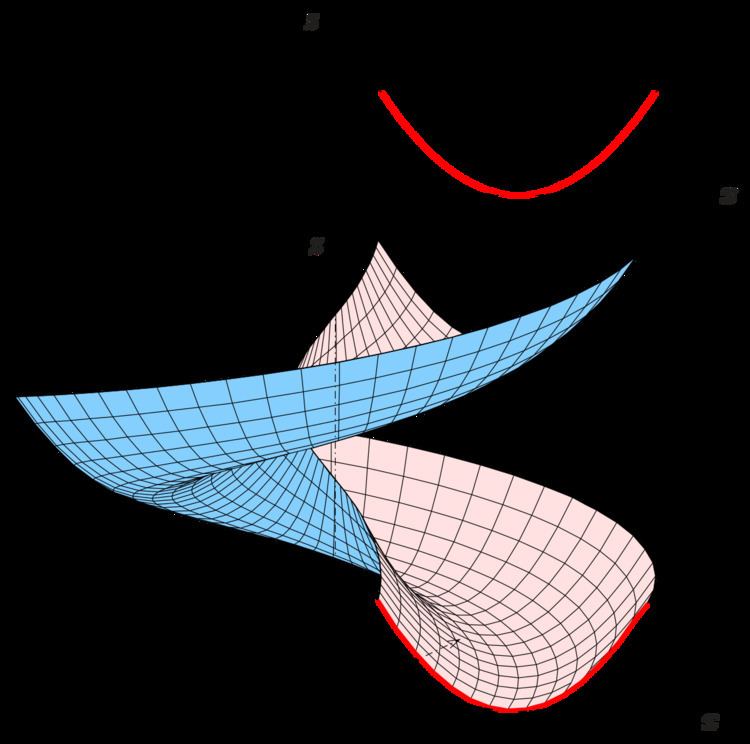 | ||
In geometry, a generalized helicoid is a surface in Euclidean space generated by rotating and simultaneously displacing a curve, the profile curve, along a line, its axis. Any point of the given curve is the starting point of a circular helix. If the profile curve is contained in a plane through the axis, it is called the meridian of the generalized helicoid. Simple examples of generalized helicoids are the helicoids. The meridian of a helicoid is a line which intersects the axis orthogonally.
Contents
- Screw motion of a point
- Screw motion of a curve
- Types
- On closed ruled generalized helicoids
- On the tangent developable type
- Circular generalized helicoids
- References
Essential types of generalized helicoids are
In mathematics helicoids play an essential role as minimal surfaces. In the technical area generalized helicoids are used for staircases, slides, skrews and pipes.
Screw motion of a point
Moving a point on a screwtype curve means, the point is rotated and displaced along a line (axis) such that the displacement is proportional to the rotation-angle. The result is a circular helix.
If the axis is the z-axis, the motion of a point
In case of
Screw motion of a curve
The screw motion of curve
yields a generalized helicoid with the parametric representation
The curves
The curves
Example: For the first picture above, the meridian is a parabola.
Types
If the profile curve is a line one gets a ruled generalized helicoid. There are four types:
(1) The line intersects the axis orthogonally. One gets a helicoid (closed right ruled generalized helicoid).(2) The line intersects the axis, but not orthogonally. One gets an oblique closed type.If the given line and the axis are skew lines one gets an open type and the axis is not part of the surface (s. picture).
(3) If the given line and the axis are skew lines and the line is contained in a plane orthogonally to the axis one gets a right open type or shortly open helicoid.(4) If the line and the axis are skew and the line is not contained in ... (s. 3) one gets an oblique open type.Oblique types do intersect themselves (s. picture), right types (helicoids) do not.
One gets an interesting case, if the line is skew to the axis and the product of its distance
Remark:
- The (open and closed) helicoids are Catalan surfaces. The closed type (common helicoid) is even a conoid
- Ruled generalized helicoids are not algebraic surfaces.
On closed ruled generalized helicoids
A closed ruled generalized helicoid has a profile line that intersects the axis. If the profile line is described by
If
If
consist of double points. There exist infinite double curves. The smaller
On the tangent developable type
For the directrix (a helix)
one gets the following parametric representation of the tangent developable surface:
The surface normal vector is
For
Circular generalized helicoids
There are 3 interesting types of circular generalized helicoids:
(1) If the circle is a meridian and does not intersect the axis (s. picture).(2) The plane that contains the circle is orthogonal to the helix of the circle centers. One gets a pipe surface(3) The circle's plane is orthogonal to the axis and comprises the axis point in it (s. picture). This type was used for baroque-columns.